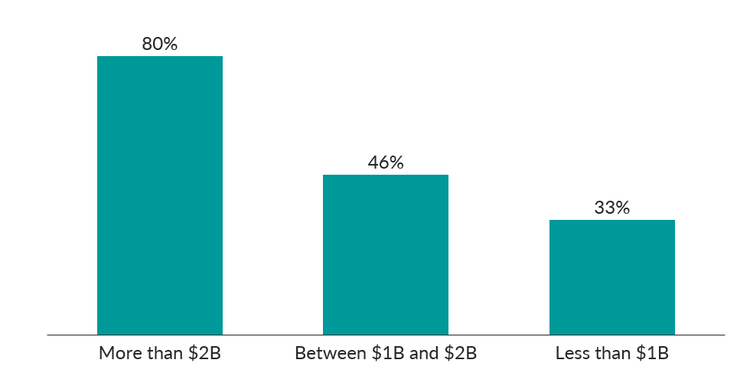
By Andrew Alesbury, Vidit Jain, and Simba Mariwande
Although less than half of the 100 largest law firms in the U.S. have an ESG policy and only 8% have an ESG or sustainability report, nearly all offer ESG legal services to clients. The result is industry-wide risk of greenwashing.
The commercial world – and by extension the legal world – is abuzz with activity relating to the rise of ESG and sustainability. Whether it is the highly anticipated climate disclosure rules from the Securities and Exchange Commission which would affect all publicly traded companies in the U.S. (an update is expected to be released in April 2023), the fact that 96% of S&P 500 companies already routinely publish sustainability reports, or Article 8 and 9 of the Sustainable Finance Disclosure Regulations in Europe, ESG and sustainability are proving to be critical topics for organizations across the U.S.
It is no surprise then that law firms are offering ESG services to their clients in growing numbers. Indeed, as Telesto Strategy’s recent analysis on ESG in the legal sector shows, more than 95% of Am Law 100 firms (the 100 largest law firms in the U.S.) offer some form of ESG-related legal services to their clients, highlighting the centrality of this growing topic to the practice of law.
However, upon examining how law firms are integrating ESG into their own operations, it is clear that the industry as a whole is not “practicing what it preaches” and is at substantial risk of greenwashing: of the more than 95% of Am Law 100 firms offering ESG services, less than half have a publicly disclosed ESG policy (defined as any sort of statement which indicates that they have recognized the importance of ESG topics and are pursuing initiatives which address them). Broken down by firm size, the risk of greenwashing becomes even more apparent within specific pockets of the sector, as only 46% of Am Law 100 firms with gross revenues between $1B and $2B and 33% of firms with gross revenues less than $1B currently have any sort of ESG policy.
Share of Am Law 100 Firms with an ESG Policy by 2021 Gross Revenues
(% of firms)

While a public ESG policy is certainly an important step for any law firm to take if it hopes to be viewed as a credible authority on ESG, it is far from sufficient. In the case of most law firms’ ESG policies, they tend to be cursory declarations which are light on specifics rather than clear roadmaps to ESG impact with defined measures by which to be held accountable.
Much more desirable from a “practicing what you preach” perspective than a policy is an ESG or sustainability report. Unlike policies, reports nearly always include a few key elements which set them apart from their specifics-light cousins. For example, they typically include:
Commitments from the firm’s leadership to allocate resources towards addressing ESG
Materiality assessments, where the most “material” ESG topics for the firm are identified
Emissions reporting, where the firm’s greenhouse gas (GHG) emissions are tracked against its Scope 1, 2, and 3 targets
Defined initiatives which detail how the firm will contribute to ESG goals and how these initiatives map to the UN’s Sustainable Development Goals
Impact vignettes, where testimonials of the firm’s positive contributions in the larger community are described
Given the higher bar that ESG / sustainability reports impose, it may come as no surprise that they are even more rare among law firms than policies are. Indeed, only eight Am Law 100 firms have an ESG or sustainability report, implying that more than 90% of law firms are at significant risk of greenwashing. And with a growing number of companies now requiring their legal counsel to have ESG elements in place (e.g., emissions reporting for purposes of rolling up to their own Scope 3 emissions), it is becoming urgent from both a business and regulatory perspective that law firms address their adherence to ESG principles.
So, what can law firms do to address the greenwashing risk?
The first place to start is by setting aside resources to develop an ESG policy and report – and the sooner the better, as looming SEC requirements and others in the European Union all point towards a world where ESG is likely to become a staple in the regulatory landscape. For firms where the tools and staffing resources are not available (recent studies suggest as many as 85% of executives at U.S. companies feel they do not have the right tools or people in place to conduct ESG and sustainability reports), advisory firms, like Telesto Strategy, can be helpful partners in getting your ESG / sustainability journey started.
The second key activity is to monitor progress against your commitments and consider evolving your firm’s goals over time. Net zero targets, for example – where an organization commits to offsetting all GHG emissions with equivalent sequestration efforts – represent a highly ambitious commitment to sustainability but are gaining popularity (over a third of the world’s largest companies have net zero commitments). Firms which want to make clear their commitment to good governance can make public commitments to protecting human rights and only serve clients which have similar commitment.
Finally, it is vital to routinely reassess whether your firm is living up to its commitments. The challenging part of any firm’s ESG journey is not developing a policy or a report but in living up to them. Reevaluating whether your firm is doing enough and living up to impactful commitments is critical to avoiding the risk of greenwashing.


